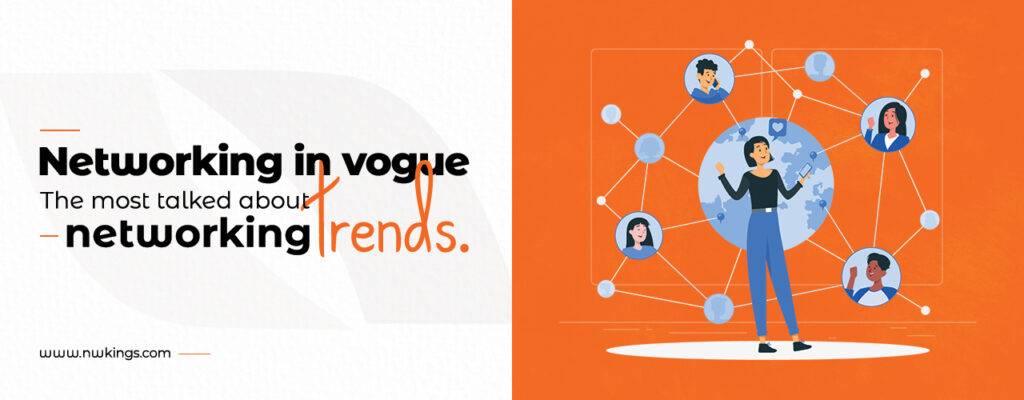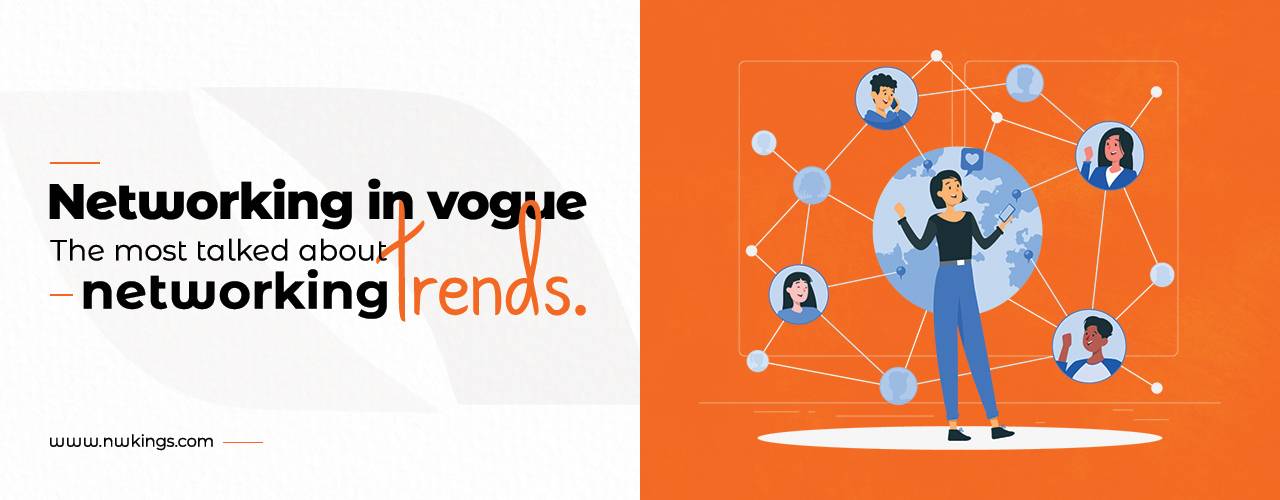
Networking has itself been in vogue for a while now, it has been emerging as one of the most talked about IT domains. Networking is growing at a pace that is alarming when compared to other industries.
We all are a part of networking be it consciously or unknowingly. So it is pretty obvious that networking affects us in some or the other way, in our daily lives. The trends are also responsible for predicting the Networking certifications, courses that one should go for
Hence, what has been trending in Networking is to affect us as well. So in today’s blog we’re going to have a look at certain networking trends and the changes that’ll bring.
Networking Trends creating a buzz:
There are multiple trends that have been creating a buzz in the digital world, but we shall concentrate upon the networking trends in this blog. These trends are predictions of experts for this decade that is beginning from 2022.
The 3 top trends as per research are:
- WiFi 6
- 5G
- Artificial Intelligence
What is Wi-Fi 6? Is it really that much faster?
We’ve all heard about Wi-Fi 6. Do we understand what it actually is? Let’s have a deeper look at what it is.
Wi-Fi 6 is the new generation of wireless internet. It is the new generation of Wi-Fi which has a few more additional technologies that will make speed and working more efficient.
What does it bring to the table?
- To put it in simple words, the speed this generation of Wi-Fi brings is the maximum speed in theoretical nature, way more than, the needed speed ever.
- But the theoretical speed introduced by Wi-fi 6 is still a notable fact.
There are claims that this new generation of Wi-Fi brings more than just speed to the table. - This generation also brings about an improved network for when a number of devices are connected. Which happens to be a vital goal as reports suggest that, during the time of Wi-Fi 5 launch there were as many as 5 connections in a household. Now it has accelerated to 9-10 connections.
- If researchers are to be believed it’ll grow and rise to be a 50 as an average in the coming years.
- It also introduces some technologies that are helpful in mitigating issues, which surface when a number of devices are put on a single network.
- It facilitates communication for routers with multiple devices at once.
- It enables routers to send data to multiple devices in the same broadcast and also lets Wi-Fi devices schedule check-ins with the router.
- It is also said to improve the battery life.
- It is said to provide better security as well.
All these out of the box features and reports still suggest that Wi-Fi 6 is just getting started. It will arrive in all high end phones before the end of this year. Wi-Fi 6 will be more common by the coming year and will eventually become a household name. The Wi-Fi alliance will be launching their Wi-fi 6 certification around this winter, which is developed to ensure compatibility across all Wi-Fi devices. Although there isn’t a said need to pass this certification, it stands as a proof of the industry’s preparedness for Wi-Fi 6’s arrival.
5G, how is it different from previous generations?
Before we jump on to understand 5G let’s rewind a little and have a look at the previous generations of mobile networks and 5G.
Let’s start from the start:
First generation- 1G
This generation came out in the 1980’s. It delivered an analog voice.
Second generation- 2G
The second generation came out in the early 1990s. It introduced digital voice. For instance CDMA- Code Division Multiple Access.
Third Generation – 3G
The third generation 3G was launched in the early 2000s, it brought mobile data, as we know it. For eg; CDMA2000.
Fourth Generation -4G
The fourth generation of 4G LTE ushered in the era of mobile broadband. It started doing rounds in the year 2010.
All these generations were designed to build and deliver 5G, which is solely aimed at improving overall connectivity.
There are many questions that surround the launch of 5G, we will address a few of them in this blog today.
Who uses 5G?
The users of 5G are many and hail from diverse fields. 5G is used across mainly across three services:
1. Enhanced mobile broadband.
2. Mission-critical communications.
3. Massive IoT.
5G is defined in a way that it possesses forward compatibility; which can be defined as the ability to flexibly support future services that are not known to us today.
Let us have closer look at these service areas:
1. Enhanced Mobile Broadband:
They make our smartphones better, that is undebatable. But along with that 5G also makes mobile technology compatible to utilize things such as VR and AR with even faster, and more uniform data rates. It also offers lower latency and even lower cost-per-bit.
2. Mission-Critical Communications:
5G is potent enough to enable new services that can transform industries, organizations with ultra-reliable, available and low latency links like remote control for vital infrastructures, vehicles, and many medical procedures.
3. Massive IoT :
5G is capable of establishing connections between a massive number of embedded sensors in a virtual environment. This can be facilitated by its ability to scale down in data rates, power and also mobility. This can provide extremely low cost connectivity solutions.
How is 5G affecting us?
5G is bound to affect our lives, so much so that it can transform our lives. It can facilitate faster download speeds, low latency and way more capacity. It provides connectivity for billions of devices.
For instance, with the availability of 5G an individual can access cloud services instantly.
Multiplayer cloud gaming, shopping virtually sitting at the comfort of their own homes, real-time video translation.
5G has way more impact than any of the previous generations.A study reveals that the 5G value chain alone is worthy of supporting 22.8 million jobs. Though nothing is guaranteed, 5G seems promising to address issues like unemployment and seems like it will have a positive effect on the economy as well.
Artificial Intelligence:
Hey Siri, call ABC, Alexa turn off the lights. This is a demonstration of human laziness and also artificial intelligence at work.
In simplest of words Artificial Intelligence is intelligence that is being displayed by machines and not humans.
It aims to replicate human intelligence. Although it is impossible to replicate human intelligence.
Artificial intelligence research has been defined as the field of study of intelligent agents, referring to any system that picks up from the environment and takes actions accordingly.
There are three types of Artificial Intelligence :
1. Narrow artificial Intelligence. (ANI) This refers to AI that has a narrow range of abilities. For instance: Apple’s face recognition.
2. Artificial general Intelligence.(AGI) This refers to capabilities equivalent to humans. Example of AGI is: Self driving cars.
3. Artificial SuperIntelligence (ASI) This AI refers to capabilities that are way more than that of humans. It has been found that it would be close to impossible for humans to contain Artificial Superintelligence.
How Artificial Intelligence has an effect on us:
Artificial intelligence is a huge part of daily life and plays a crucial role in society as well. Artificial intelligence is bound to transform lives all across the globe. The effect artificial is having or going to have still remains up for debate.
Few conservatives argue that artificial intelligence will eventually take over and we shall encounter numerous problems.
Even if it’s the case we should applaud the ease artificial intelligence has brought and focus on the ways to counter any kind of issue if it begins.
Conclusion:
The trends in Networking are ever evolving and constantly changing as well. For an individual looking to make a career in the world of IT and especially in the field of networking, he/she should keep up with these trends and be well read.


